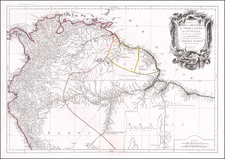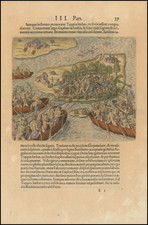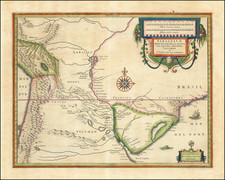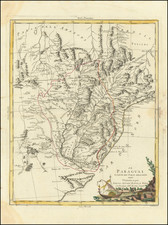Striking Seventeenth-Century Manuscript Chart, from the Famed Thames School of Chartmakers
Fine hand drawn sea chart of Fernando de Noronha, in the western Atlantic, from the era of English Buccaneers and Pirates, produced by an unnamed Thames School chartmaker.
The chart shows the island as if approached from the northeast. As with many charts, this one shows the shoreline as seen from a ship, emphasizing high ground and watering spots. The bay, shown in plan, includes notes on the quality of the waves and the ground, as well as shows safe anchorages and obstructions.
The most distinctive feature—and the calling card of the Thames School—is the ornate compass rose. Such beautiful detail work underlines the skill of the maker and suggests this chart as a presentation item. This example, which comes from the collection of Alexander Vietor, who curated the rare map and book devision at Yale for 35 years (1943-1978), bears the number 47. This is likely the chart number from an English example of a Deroterro, a type of hand drawn Spanish sea atlas maintained by Spanish Mariners, typically plying the waters off South America in the late 16th and 17th Centuries. William Hacke, the celebrated "Pirate Chartmaker", is credited with creating the first such English Deroterro, which is referred to as the Buccaneer's Atlas, from a Spanish Deroterro captured by the English pirate Bartholomew Sharpe in the mid 17th Century.
Fernando de Noronha
Fernando de Noronha was sighted early in the encounter between Europeans and the Americas. By 1500, Spanish charts already showed it. It is included in the Cantino Planisphere (1502) as Quaresma, although that designation is still contested by scholars.
The earliest known landing at the islands was on August 10, 1503, when a group of Lisbon merchants, led by Fernão de Loronha, financed an expedition to explore it more closely. Led by Captain Gonçalo Coelho, the crews included Amerigo Vespucci, who wrote of the trip. The flagship hit a reef near the main island and foundered. Vespucci made it to a safe anchorage and called the island St. Lawrence, as it was the feast day of that saint.
In 1504, King Manuel I of Portugal granted the island to Loronha as a charter. It was now called St. John’s Island, renamed by another Portuguese visitor in search of Vespucci. Over time, however, the archipelago came to be called after Loronha and his family, who maintained their ownership until the 1560s. Noronha is a common misspelling of Loronha.
Later in the sixteenth century, Fernando de Noronha became the central collection point for brazilwood, a trade in which Loronha was heavily involved. Later, in 1719, the pirate Bartholomew Roberts (Black Bart) spent time on the island and points to continued English interest in the island that is reflected in this chart.
The Thames School
Fernando de Noronha was first surveyed and scientifically charted by Captain Henry Foster of HMS Chanticleer on a surveying expedition in 1828. However, it was also charted in various levels of detail long before by the Spanish, Portuguese, and, as this chart shows, the English. The style of this chart dates it to circa 1670-80, when English privateers and buccaneers were roving the western Atlantic in search of ships and trade, both legal and illicit.
This was the heyday of the Thames School of chartmakers, who in turn patterned their work on the Mallorcan style of late portolan charts. The demand for English nautical charts increased sharply from the mid-sixteenth century. Chartmakers gravitated to Thames-side enclaves like Wapping, Ratcliff, the Minories, Limehouse, and Stepney to fill this demand.
While many engraved charts were available (and some members of the Thames School produced printed charts), the Thames School specialized in hand-drawn charts, often on vellum. Thomas R. Smith has traced at least seven generations of masters and apprentices who formed the school of artisan practitioners along the banks of the Thames, hence their name. Many of these were part of the Drapers Company, underlining that map and chartmakers were part of many companies and not necessarily attached to the Stationers as is commonly assumed. Members included John Burston, Nicholas Comberford, John Thornton, Joel Gascoyne, John Daniell, Nicholas Reynolds, Thomas Lupo, Thomas Hood, Gabrieell Tatton, and John (father) and Robert (son) Friend.
The most famous, and one of the last, members of the Thames School was William Hacke. Hacke made over 300 charts, including lavish presentation atlases based on a Spanish Deroterro captured by the pirate Bartholomew Sharpe. Several examples of these atlases survive, preserving the humped hills, spiked writing, careful line work, refined use of gold and color, and elaborate compass roses that were characteristic of the Thames School style. While this chart does not appear to be by Hacke (based on a comparison of the handwriting and the details of the compass rose), it was completed by a member of the School and fits within their important oeuvre.
Rarity and Provenance
Any Thames School work is rare, especially separate charts like this. It is a surprising and scarce survival.
This chart was formerly in the collection of Alexander Orr Vietor (1913 – 1981), famed curator of maps at Yale University from 1943 to 1978, and thence by descent.









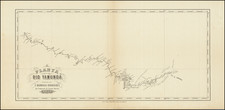
![[ Rio de Janeiro / Guanabara Bay ] Plan de la Baye et Port de Rio Janeiro Situee a la Cost due Bresil . . . Levee Geometriquement par le P. Capassi . . . 1785](https://storage.googleapis.com/raremaps/img/small/97782.jpg)
